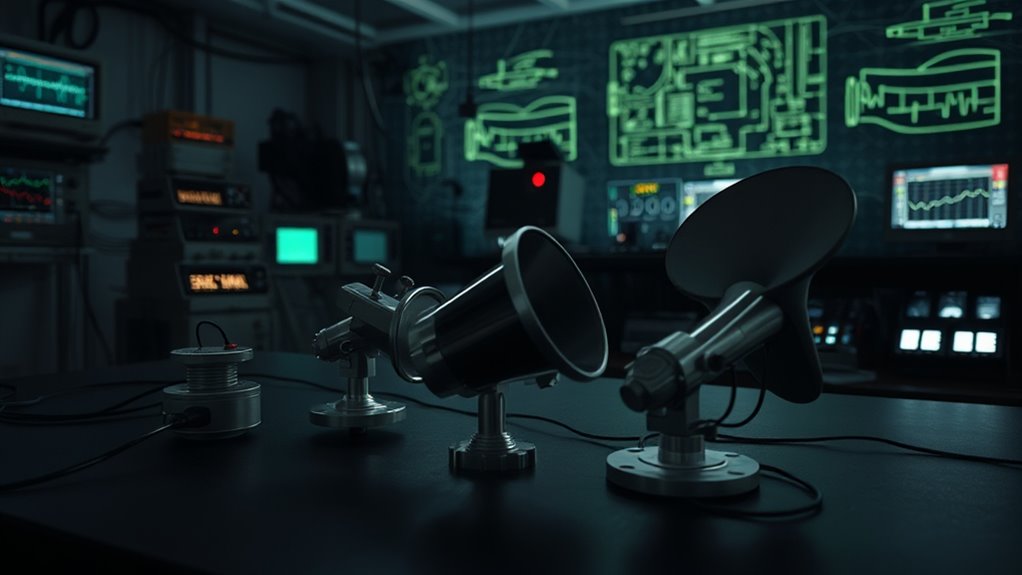Infrasound, low-frequency sound waves you can’t hear but can feel, may trigger fear, hallucinations, and physical reactions that explain many haunting stories. These waves affect your senses and brain, causing sensations of dread and unease. Environmental sources or structures can generate infrasound without you realizing it. By understanding how infrasound influences perception and emotions, you’ll uncover the hidden science behind paranormal experiences and why some places feel so unnervingly strange.
Key Takeaways
- Infrasound can induce feelings of fear and dread by causing auditory hallucinations and sensory distortions.
- Low-frequency vibrations can trigger primal fear responses, increasing anxiety and physiological stress without conscious awareness.
- Historical and cultural accounts link infrasound exposure to paranormal experiences like hauntings and supernatural encounters.
- Environmental infrasound sources, such as buildings or natural events, may subtly influence emotions and perception in haunted spaces.
- Understanding and detecting infrasound is crucial to mitigate its subconscious effects and prevent potential psychological or health impacts.
What Is Infrasound and How Does It Work?

Have you ever wondered how certain sounds can be felt even if you can’t hear them? That’s the power of infrasound, a type of sonic wave below our audible range. These low-frequency waves can create auditory illusions, tricking your brain into perceiving sensations that aren’t actually there. Infrasound works by traveling through the air and vibrations, often unnoticed, until it interacts with your body. When these sonic waves reach you, they can induce feelings of unease or discomfort, even without hearing a sound. It’s this subtle yet impactful nature that makes infrasound so intriguing. While you might not hear it, your body senses it. That’s how infrasound influences your perception and emotions, often in ways you can’t consciously understand. Moreover, its vetted properties contribute to its ability to subtly affect human emotions and perceptions without conscious awareness. Its psychological effects can sometimes trigger fear or anxiety even when the source of the sound remains unseen or undetectable. Additionally, research suggests that the frequency range of infrasound plays a crucial role in its impact on human physiology and psychology. Recent studies also indicate that infrasound can influence autonomic nervous system responses, further affecting emotional states and physical sensations.
The History of Infrasound and Its Mysterious Uses

Throughout history, humans have been captivated by the mysterious properties of infrasound, often unknowingly harnessing its power for various purposes. Ancient civilizations, like the Egyptians and Greeks, believed in sound’s spiritual and healing properties, possibly utilizing low frequencies. Some cultures incorporated infrasound into their musical applications, creating deep, resonant sounds that stirred emotions or invoked reverence. These early uses suggest an awareness of infrasound’s effects long before scientific understanding emerged. The table below highlights notable examples of infrasound’s mysterious uses:
| Civilization | Application | Purpose |
|---|---|---|
| Ancient Egypt | Rituals and spiritual ceremonies | Connecting with gods |
| Greek Temples | Architectural acoustics to amplify feelings | Religious experiences |
| Indigenous Tribes | Drumming and chanting for trance states | Shamanic rituals |
| Medieval Europe | Alleged use in torture or psychological influence | Power and control |
| Modern times | Musical applications and research | Exploring sound effects |
Additionally, modern research suggests that infrasound may also have psychological effects, influencing mood and perception in subtle ways. Some studies indicate that exposure to infrasound can induce feelings of unease or fear, which may explain certain supernatural phenomena reported throughout history. It is also believed that these low-frequency sounds could be used intentionally to manipulate emotions or perceptions in various contexts. Recent studies have also shown that sound frequencies can impact physiological responses, adding another layer to understanding infrasound’s mysterious influence. Furthermore, ongoing research continues to uncover the complex interactions between infrasound and human perception, revealing how subtle sound waves affect our senses beyond conscious awareness.
How Infrasound Can Induce Fear and Anxiety

The mysterious uses of infrasound in ancient times hint at its powerful influence on human emotions, especially feelings of fear and anxiety. When exposed to infrasound, your brain can create auditory hallucinations, making you hear sounds that aren’t there. This effect is closely tied to sensory distortion, where your perceptions of reality become blurred. You might hear whispers, screams, or unexplained noises that trigger a primal fear response. These sensations can make you feel uneasy or panicked, even if you know the sounds are fabricated. Infrasound’s ability to manipulate your sensory experience taps into deep-seated fears, amplifying feelings of dread without any obvious source. This connection explains how low-frequency waves can induce a haunting sense of terror and anxiety. Understanding sensory distortion helps clarify why infrasound can have such profound psychological effects, especially when combined with environmental cues that reinforce feelings of unease. Recognizing the audio hallucination process can assist in understanding how these low-frequency sounds are used to manipulate emotions and perceptions. Additionally, the persistence of these sounds can lead to psychological stress, further intensifying feelings of fear. Moreover, the presence of resonant frequencies can enhance the intensity of these hallucinations, making the experience even more visceral and unsettling.
The Science Behind Infrasound’s Effects on the Human Body

Ever wondered how infrasound affects your body at a physiological level? When exposed to infrasound, your ears can perceive auditory illusions—sounds that aren’t actually there—that trigger specific physiological responses. These low-frequency waves can influence your inner ear and brain, causing sensations of unease or discomfort. Infrasound activates your autonomic nervous system, leading to increased heart rate, sweating, or even nausea. Researchers believe these effects stem from the way infrasound interacts with your auditory system, creating distorted perceptions that mimic feelings of fear or dread. Your body’s stress response is stimulated, heightening alertness and amplifying emotional reactions. This physiological cascade explains why infrasound can produce such intense, often unsettling, physical and psychological effects.
Notable Cases and Reports of Infrasound-Induced Experiences

Throughout history, certain mysterious incidents have been linked to infrasound exposure, sparking curiosity and debate. Cases like the Enfield Poltergeist, the Devil’s Kettle, and the Dyatlov Pass Incident have been examined for possible infrasound connections. Exploring these reports can shed light on how infrasound might influence human perception and behavior in extraordinary situations. Additionally, understanding sound frequency ranges involved in infrasound can provide insight into its potential effects on humans.
The Enfield Poltergeist
Although the Enfield poltergeist case gained fame for its eerie phenomena, some researchers suggest that infrasound might have fueled the reported experiences. This case, rooted in urban legends and cultural symbolism, captured the public’s imagination, blending folklore with supposed supernatural activity. Infrasound’s low-frequency waves can cause feelings of anxiety, unease, and even hallucinations, which could explain some of the poltergeist’s strange manifestations. By influencing perception, infrasound may have amplified the fear and confusion felt by those involved. While skeptics argue that psychological factors played a role, understanding infrasound offers a scientific perspective on how such phenomena could occur. The Enfield case remains a compelling example of how cultural narratives intersect with potential physical influences like infrasound.
The Devil’s Kettle Case
The Devil’s Kettle, a mysterious waterfall in Minnesota where half the river disappears into a hole, has long fascinated explorers and skeptics alike. Some believe that acoustic engineering and sound therapy techniques could explain the strange phenomena observed there. Infrasound, with its low frequencies, may cause unusual sensations or feelings of unease among visitors, similar to reports from other infrasound-related cases. While the waterfall itself remains an enigma, recent studies suggest that underground sound waves or natural acoustic phenomena might influence perception around the site. These effects can induce discomfort or hallucinations, which contribute to the mysterious reputation of the Devil’s Kettle. Understanding the role of infrasound in such environments highlights how sound therapy and acoustic engineering intersect with unexplained phenomena.
The Dyatlov Pass Incident
The Dyatlov Pass Incident remains one of the most perplexing mysteries in recent history, with many theories attempting to explain the strange injuries and circumstances surrounding the hikers’ deaths. Some researchers suggest infrasound played a role by generating sound waves that triggered biological responses in the hikers. These responses could have caused panic, hallucinations, or physical symptoms, leading to their irrational actions.
- The sound waves may have induced a state of extreme fear or disorientation.
- The biological responses to infrasound could explain the mysterious injuries, such as internal trauma without external wounds.
- This phenomenon offers a plausible explanation for the hikers’ frantic escape from their tent, driven by an unseen, infrasound-induced panic.
Infrasound in Architecture and Its Hidden Presence

Have you ever wondered how inaudible vibrations subtly influence the spaces around us? In architecture, infrasound’s presence often goes unnoticed, yet it impacts how environments feel. Architects consider acoustic design to manage sound, but infrasound can bypass typical soundproofing techniques, silently affecting occupants. Buildings like churches or concert halls sometimes unintentionally generate infrasound due to structural resonances or HVAC systems. These low-frequency vibrations can create discomfort or unease without you realizing why. Modern soundproofing techniques focus on blocking higher-frequency noise, but infrasound requires specialized solutions—like vibration isolation and structural damping—that many buildings lack. Recognizing the hidden presence of infrasound in architectural acoustics helps us understand how spaces influence mood, perception, and even subconscious fears.
The Connection Between Infrasound and Paranormal Phenomena

Many researchers believe that infrasound may play a role in the eerie sensations and unexplained phenomena people often associate with haunted locations. These sounds can cause physical effects, influencing perceptions in ways linked to cultural interpretations and mythological origins.
- Some theories suggest that infrasound amplifies feelings of fear and unease, fueling stories of spirits or supernatural entities.
- Cultural interpretations often interpret these sensations as encounters with ghosts or divine beings, shaping folklore and myths.
- The mythological origins of many haunted tales may have roots in these physical responses to low-frequency sound, blurring the line between science and superstition.
Understanding this connection helps explain why paranormal phenomena are so widespread across cultures, often rooted in infrasound’s haunting effects.
Detecting and Measuring Infrasound: Tools and Techniques

Detecting and measuring infrasound requires specialized tools capable of capturing low-frequency sound waves that are often inaudible to humans. Acoustic measurement devices, such as infrasound microphones and pressure sensors, help you detect these vibrations accurately. Biological detection methods, like monitoring animal responses, can also indicate infrasound presence. These tools measure amplitude, frequency, and duration of the waves, providing essential data for analysis. Here’s a quick overview:
| Tool/Technique | Purpose | Key Feature |
|---|---|---|
| Infrasound Microphone | Capture low-frequency sounds | Sensitive to inaudible waves |
| Pressure Sensors | Measure sound wave pressure | High precision |
| Animal Monitoring | Detect biological responses | Indicates infrasound presence |
Using these tools, you’ll better understand infrasound’s effects and how to quantify its presence effectively.
Future Research and the Potential Risks of Infrasound

As research progresses, you’ll need to explore how infrasound might affect mental health in ways we haven’t yet understood. Safety standards and regulations must keep pace with these discoveries to protect public well-being. Addressing these unresolved risks is essential for responsible use and management of infrasound technology.
Unexplored Psychological Effects
While research into the psychological effects of infrasound remains limited, understanding its potential risks is essential for future investigations. You may not realize that infrasound could subtly influence your subconscious, leading to psychological manipulation without your awareness.
- Infrasound might alter perception, making you more susceptible to suggestion or fear.
- It could induce stress or anxiety, impacting mental well-being over time.
- The potential for subconscious influence raises concerns about covert use in environments designed to manipulate emotions.
These unexplored effects suggest infrasound’s capacity to affect your mind beyond physical sensations, highlighting the need for further research into its psychological impacts and risks.
Safety and Regulation Concerns
Given the growing use of infrasound in various applications, establishing safety standards and regulatory measures is essential to prevent potential health risks. You need effective regulatory oversight to monitor infrasound levels in environments like concerts, industrial sites, and transportation systems. Without proper regulation, prolonged exposure could lead to issues such as headaches, fatigue, or even psychological effects. Ensuring public safety requires clear guidelines on safe exposure limits and regular monitoring. Governments and organizations must collaborate to develop these standards based on scientific research. By doing so, they can minimize health hazards and maintain public trust. Infrasound’s potential dangers demand proactive regulation to protect individuals while allowing its beneficial uses to continue responsibly.
Frequently Asked Questions
Can Infrasound Be Used Intentionally for Psychological Manipulation?
You might wonder if infrasound can be used intentionally for psychological manipulation. It’s true that infrasound has a significant psychological impact, causing discomfort, anxiety, or fear. Manipulation techniques could involve using low-frequency sounds to influence mood or perception covertly. While some research suggests potential, ethical concerns arise about using such methods without consent. Overall, infrasound’s ability to manipulate emotions relies on understanding its effects and applying them carefully.
Are There Any Health Risks Associated With Long-Term Infrasound Exposure?
Ever wondered if long-term infrasound exposure might harm you? You might not realize it, but it can be linked to health risks like noise pollution and sleep disturbances. Prolonged exposure can cause headaches, fatigue, and stress, affecting your overall well-being. Should we ignore the potential dangers of persistent low-frequency sounds? It’s wise to be cautious, especially if you spend a lot of time near sources of infrasound, to protect your health.
How Do Different Frequencies of Infrasound Affect Human Perception?
You perceive infrasound differently depending on its frequency modulation and your perception thresholds. At certain low frequencies, you might not consciously notice the sound, but it can cause discomfort or unease. As the frequency increases closer to your perception threshold, you become more aware of it, potentially triggering physical or emotional responses. Different frequencies can influence your perception and reactions, even if you’re not fully aware of the sound itself.
Is Infrasound Detectable by the Human Ear or Only With Equipment?
You can’t detect infrasound through auditory detection or sound perception because it’s below the human hearing range, typically under 20 Hz. Your ears don’t pick up these low frequencies naturally, so you need specialized equipment to measure or visualize infrasound. While you might not hear it, infrasound can still affect your body and perception, often causing feelings of unease or discomfort without conscious awareness.
What Are the Legal Regulations Regarding Infrasound Emissions in Public Spaces?
You might wonder if there’s a limit to how much infrasound noise pollution is allowed in public spaces. Environmental regulations set specific standards to control low-frequency emissions, ensuring they don’t disturb or harm people. These rules vary by region, but generally, authorities monitor and restrict infrasound levels to protect public health and safety. Staying informed about local laws helps you understand how infrasound emissions are managed and kept in check.
Conclusion
As you walk through a silent forest or stand beneath a distant thunderstorm, infrasound quietly weaves through the air, stirring fears you can’t quite explain. Its unseen presence whispers beneath your awareness, stirring shadows of anxiety and mystery. While invisible, its haunting influence reminds you that some fears are rooted in the unseen, lurking just beyond perception. Stay curious, but also cautious, for infrasound’s silent reach can profoundly affect your mind and senses.









